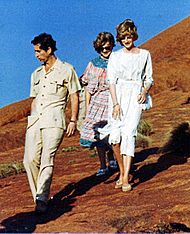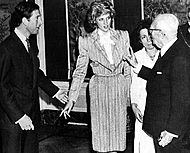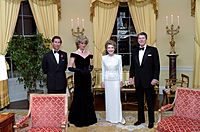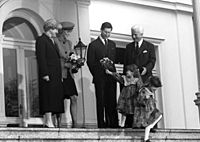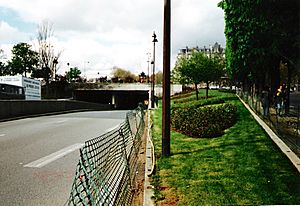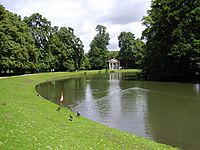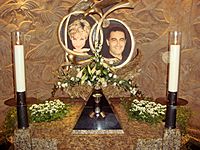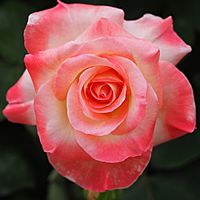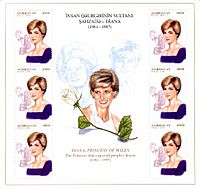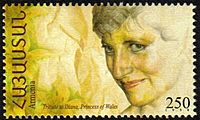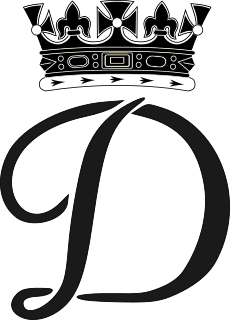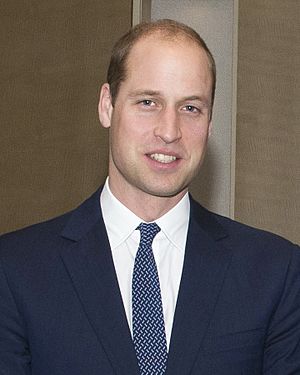Diana, Princess of Wales facts for kids
Quick facts for kids Diana |
|
|---|---|
| Princess of Wales (more) | |
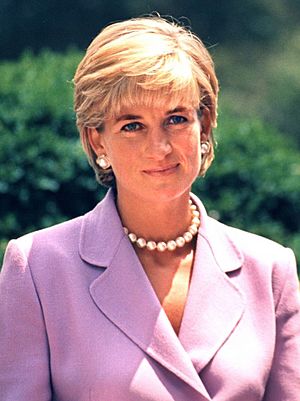
Diana in June 1997
|
|
| Born | Diana Frances Spencer 1 July 1961 Park House, Sandringham, Norfolk, England |
| Died | 31 August 1997 (aged 36) Pitié-Salpêtrière Hospital, Paris, France |
| Cause of death | Injuries sustained in a car crash |
| Burial | 6 September 1997 Althorp, Northamptonshire, England |
| Spouse | |
| Issue | |
| House |
|
| Father | John Spencer, 8th Earl Spencer |
| Mother | Frances Roche |
| Education |
|
| Signature | |
 |
|
Diana, Princess of Wales (born Diana Frances Spencer; 1 July 1961 – 31 August 1997), was a very famous member of the British Royal Family. She was the first wife of King Charles III (who was then Prince Charles) and the mother of Prince William and Prince Harry. Diana was known around the world for her charity work and her amazing style, which made her very popular.
Diana was born into a noble family and grew up near the royal family's home. In 1981, while working as a helper at a nursery school, she got engaged to Prince Charles. Their wedding at St Paul's Cathedral was a huge event, watched by millions. She became the Princess of Wales and was loved by the public. They had two sons, William and Harry, who were then second and third in line to the throne. Diana and Charles faced difficulties in their marriage and separated in 1992. They officially divorced in 1996.
As Princess of Wales, Diana carried out royal duties for the Queen. She was famous for her unique way of helping charities. She supported causes for children and the elderly. Later, she became well-known for her work with AIDS patients and her campaign to remove landmines around the world. She also helped raise awareness for people with cancer and mental illness. Diana was known for being kind and friendly, which made people love her even more. She was also a fashion leader in the 1980s and 1990s. Diana's death in a car crash in Paris led to a huge wave of sadness around the world. Her impact on the royal family and British society is still felt today.
Contents
Early Life and Family Background
Diana was born on 1 July 1961, in Park House, Sandringham, Norfolk. She was the fourth of five children of John Spencer and his first wife, Frances. The Spencer family had been close to the British Royal Family for many years. Both of Diana's grandmothers had worked for Queen Elizabeth The Queen Mother. Diana was seven years old when her parents divorced.
Education and Early Career
Diana was first taught at home by her governess. She then went to Silfield Private School and later to Riddlesworth Hall School, an all-girls boarding school. In 1973, she joined her sisters at West Heath Girls' School in Sevenoaks, Kent. She wasn't a top student in academics, but she was recognized for her great community spirit. She left West Heath when she was sixteen. Her brother Charles remembered her as being quite shy back then. Diana was a good pianist and also excelled in swimming and diving. She studied ballet and tap dance.
After a short time at a finishing school in Switzerland, Diana returned to London. She shared a flat with friends and took various jobs. She worked as a dance instructor and a helper at a pre-school called Young England School in Pimlico. She also worked as a nanny for an American family. In July 1979, her mother bought her a flat in Earl's Court, where she lived until her engagement.
Marriage to Prince Charles
Diana first met Charles, Prince of Wales, in November 1977. He was dating her sister at the time. In the summer of 1980, Charles became interested in Diana as a possible wife. They spent time together, and he invited her to meet his family at Balmoral Castle. The Queen and other royal family members liked Lady Diana. Prince Charles proposed on 6 February 1981, and Diana accepted, but they kept it a secret for a few weeks.
Engagement and Royal Wedding
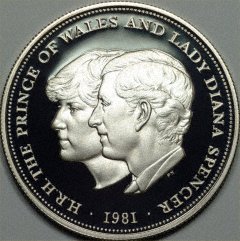
Their engagement was officially announced on 24 February 1981. Lady Diana chose a beautiful engagement ring with a large blue sapphire surrounded by diamonds. This ring later became the engagement ring of Catherine, Duchess of Cambridge. Many jewelers copied Diana's ring around the world.
After her engagement, Lady Diana left her job and lived at Clarence House for a short time, then at Buckingham Palace until her wedding. She was the first royal bride in 300 years to have had a paying job before getting engaged. Her first public event with Prince Charles was a charity ball in March 1981.
Twenty-year-old Diana married the Prince of Wales on 29 July 1981, at St Paul's Cathedral. It was called a "fairytale wedding" and was watched by 750 million people on TV worldwide. About 600,000 people lined the streets to see the couple. At the altar, Diana accidentally mixed up Charles's names. She also chose not to say she would "obey" him, which was a traditional vow. Diana wore a dress with a very long, 25-foot (7.62-meter) train.
After becoming Princess of Wales, Diana became a very important female member of the Royal Family. The Queen showed her special favor by lending her the Cambridge Lover's Knot Tiara.
Having Children
The couple lived at Kensington Palace and Highgrove House. On 5 November 1981, it was announced that the Princess was expecting her first child.
Their first son, William Arthur Philip Louis, was born on 21 June 1982, at St Mary's Hospital, London. Diana decided to take baby William with her on her first big tours of Australia and New Zealand, which was unusual for royal children but very popular with the public.
Their second son, Henry Charles Albert David (known as Harry), was born on 15 September 1984. Diana knew he would be a boy but kept it a secret from everyone, even Prince Charles.
Diana wanted her sons to have more normal experiences than other royal children. She often made her own choices about their upbringing. She chose their names, picked their schools and clothes, planned their outings, and took them to school herself when she could. She also planned her royal duties around their schedules.
Divorce Proceedings
Diana and Prince Charles divorced on 28 August 1996.
Buckingham Palace stated that the Princess of Wales would still be considered a member of the Royal Family. This was because she was the mother of the second and third people in line to the throne.
Public Life and Royal Duties
Public Appearances and Travels
In October 1981, the Princess and Prince visited Wales. Diana attended the State Opening of Parliament for the first time in November 1981. Her first solo event was turning on the Christmas lights in Regent Street. She attended Trooping the Colour in June 1982, appearing on the balcony of Buckingham Palace. Her first trip overseas was in September 1982, for the funeral of Grace, Princess of Monaco.
In 1983, she went with the Prince to Australia and New Zealand, taking Prince William with them. They met with representatives of the Māori people. Their visit to Canada in 1983 included opening the 1983 Summer Universiade in Edmonton.
In April 1985, the Prince and Princess visited Italy, joined later by William and Harry. They met with President Alessandro Pertini and had a private meeting with Pope John Paul II. In November 1985, they visited the United States, meeting President Ronald Reagan and First Lady Nancy Reagan at the White House. 1986 was a busy year, with tours to Japan, Indonesia, Spain, and Canada. In 1988, they visited Thailand and Australia for its 200th anniversary. In February 1989, Diana made a solo visit to New York. During a visit to Harlem Hospital Center, she famously hugged a seven-year-old child with AIDS, showing great kindness.
In March 1990, she and the Prince toured Nigeria and Cameroon. Diana visited hospitals and projects helping women. In May 1990, they visited Hungary, which was the first visit by royals to a former Warsaw Pact country. They met the interim President and saw a fashion show. In November 1990, they went to Japan for the enthronement of Emperor Akihito.
During the Gulf War, Diana visited Germany in December 1990 to meet soldiers' families. She also visited RAF Bruggen in January 1991 and wrote an encouraging letter to soldiers. In September 1991, Diana visited Pakistan alone and went to Brazil with Charles. In Brazil, she visited organizations helping homeless street children. Her last trips with Charles were to India and South Korea in 1992. She visited Mother Teresa's hospice in Kolkata, India, and they became friends. In 1992, the Princess of Wales visited Egypt and met President Hosni Mubarak.
Even though she announced in December 1993 that she would step back from public life, she said in November 1994 that she wanted to return part-time. She was very involved in the 125th anniversary of the British Red Cross. The Queen also invited her to the 50th anniversary of Victory in Europe Day in 1995. In February 1995, Diana visited Japan and met Emperor Akihito and Empress Michiko. In June 1995, she went to the Venice Biennale art festival. In November 1995, she took a four-day trip to Argentina for a charity event. Diana visited many other countries, including Belgium, Nepal, Switzerland, and Zimbabwe. Her 36th and final birthday celebration was held at the Tate Gallery.
Charity Work and Support
In 1983, Diana shared that she found it hard to handle the pressures of being Princess of Wales, but she was learning. She was expected to make many public appearances at hospitals and schools. From the mid-1980s, she became deeply involved with many charities. She carried out hundreds of official events each year. Diana became very interested in serious illnesses like AIDS and leprosy. Stephen Lee, a charity expert, said her impact on charity was "more significant than any other person's in the 20th century."
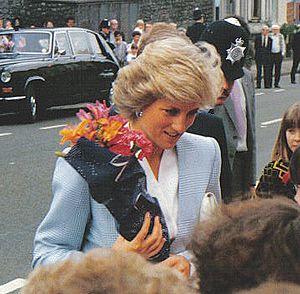
Besides health issues, Diana also campaigned for animal rights and against landmines. She supported charities helping the homeless, young people, and the elderly. From 1989, she was president of Great Ormond Street Hospital for Children. She was also a patron of Headway, a brain injury association, and the Natural History Museum. From 1984 to 1996, she was president of Barnardo's, a charity for vulnerable children. In 1988, she became a patron of the British Red Cross. She often visited Royal Brompton Hospital to comfort seriously ill patients. In 1992, she became the first patron of Chester Childbirth Appeal, helping it raise over £1 million.
Her other patronages included Landmine Survivors Network, Help the Aged, and the National AIDS Trust. She supported many organizations related to health, arts, and social welfare.

In June 1995, the Princess visited Moscow. She went to a children's hospital she had helped by providing medical equipment. In Moscow, she received the International Leonardo Prize for her work in arts, medicine, and sports. In December 1995, Diana received the United Cerebral Palsy Humanitarian of the Year Award in New York City for her good deeds. In October 1996, she was given a gold medal at a health care conference in Italy for her work with the elderly.
The day after her divorce, she announced she would step down from over 100 charities. She decided to focus on six main ones: Centrepoint, English National Ballet, Great Ormond Street Hospital, The Leprosy Mission, National AIDS Trust, and the Royal Marsden Hospital. She continued her work with the British Red Cross Anti-Personnel Land Mines Campaign.
In May 1997, the Princess opened the Richard Attenborough Centre for Disability and the Arts. In June 1997, her dresses were sold at Christie's auctions, and the money went to charities. Her last official event was a visit to Northwick Park Hospital, London, on 21 July 1997.
Helping People with HIV/AIDS
The Princess started working with AIDS patients in the 1980s. In 1989, she opened the Landmark Aids Centre in South London. She was not afraid to touch AIDS patients, even when people were unsure how the disease spread. Diana was the first British royal to make physical contact with AIDS patients. One of her first actions to remove the stigma around AIDS was holding hands with a patient in 1987. Diana said, "HIV does not make people dangerous to know. You can shake their hands and give them a hug. Heaven knows they need it."
In October 1990, Diana opened Grandma's House, a home for young AIDS victims in Washington, D.C. She was also a patron of the National AIDS Trust. In 1991, she famously hugged a patient during a visit to the AIDS ward of the Middlesex Hospital. As a patron of Turning Point, she visited its project for people with HIV/AIDS in 1992. She also started fundraising campaigns for AIDS research.
In March 1997, Diana visited South Africa and met President Nelson Mandela. In 2002, Mandela announced that his children's fund would team up with the Diana, Princess of Wales Memorial Fund to help AIDS victims. He said Diana "transformed public attitudes" by touching those with leprosy or HIV/AIDS. Mandela added that Diana used her fame to "fight stigma attached to people living with HIV/AIDS."
Campaigning Against Landmines
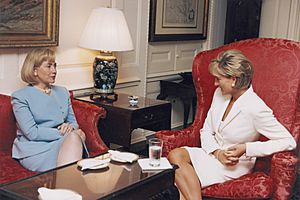
Diana was a patron of HALO Trust, an organization that clears landmines left over from wars. In January 1997, photos of Diana walking through an Angolan minefield in a special helmet and jacket were seen worldwide. Some people criticized her for getting involved in politics, but HALO says Diana's efforts greatly raised global awareness about landmines and the suffering they cause. In June 1997, she spoke at a landmines conference and traveled to Washington, D.C. to promote the American Red Cross landmines campaign. Just days before her death, from 7 to 10 August 1997, she visited Bosnia and Herzegovina to help landmine survivors.
Her work on landmines was very important in leading to the signing of the Ottawa Treaty, which banned anti-personnel landmines internationally. After her death, Robin Cook, the Foreign Secretary, praised Diana's work in the British Parliament. He said passing the Bill to ban landmines was the best way to honor her efforts.
Carol Bellamy, from UNICEF, said landmines are still dangerous for children. She urged countries that produce and store many landmines to sign the treaty. A few months after Diana's death in 1997, the International Campaign to Ban Landmines won the Nobel Peace Prize.
Supporting Cancer Patients
For her first solo official trip, Diana visited The Royal Marsden NHS Foundation Trust, a cancer treatment hospital. She later chose this charity to receive money from the auction of her clothes. The hospital said Diana helped remove the shame linked to diseases like cancer, AIDS, HIV, and leprosy. Diana became president of the hospital on 27 June 1989. She opened the Wolfson Children's Cancer Unit on 25 February 1993. In June 1996, she went to Chicago for a fundraising event and raised over £1 million for cancer research.
Children with Leukaemia (now Children with Cancer UK) was opened by the Princess of Wales in 1988, in memory of two young cancer victims. Diana met their family after their deaths, and she helped them start the charity. She supported it until her own death in 1997.
Other Important Causes
In November 1989, the Princess visited a leprosy hospital in Indonesia. After her visit, she became a patron of the Leprosy Mission, which helps people with leprosy worldwide. She remained a patron until her death and visited many of their hospitals, especially in India, Nepal, Zimbabwe, and Nigeria. She famously touched those affected by the disease when many believed it was contagious through casual contact. She said, "It has always been my concern to touch people with leprosy, trying to show in a simple action that they are not reviled." A health center in India was opened in her honor in 1999, funded by the Diana Princess of Wales Memorial Fund, to support people with leprosy and disabilities.
Diana was a strong supporter of Centrepoint, a charity that helps homeless people. She became its patron in 1992. She spoke out for young homeless people, saying they "deserve a decent start in life." Diana often took her sons, William and Harry, on private visits to Centrepoint services. One staff member said, "The young people at Centrepoint were always really touched by her visits and by her genuine feelings for them." Prince William is now the patron of this charity.
Diana also supported charities focused on social and mental health issues, like Relate and Turning Point. She became a patron of Relate in 1989 and Turning Point in 1987, regularly visiting their centers and meeting people who needed help.
Death and Public Mourning
On 31 August 1997, Diana was seriously injured in a car crash in the Pont de l'Alma road tunnel in Paris. Her companion Dodi Fayed and the driver, Henri Paul, also died. Her funeral was watched by 32.10 million people in the UK, one of the highest viewing figures ever, and by millions more around the world.
Tributes, Funeral, and Burial
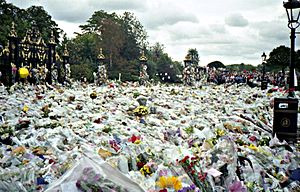
Diana's sudden death caused great sadness globally. People left flowers, candles, cards, and messages outside Kensington Palace for months. Her coffin, covered with the royal flag, was brought to London from Paris by Prince Charles and Diana's sisters. It was then placed in the Chapel Royal at St James's Palace.
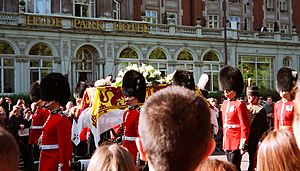
Diana's funeral took place at Westminster Abbey on 6 September. The day before, Queen Elizabeth II gave a special TV speech honoring her. Diana's sons, William and Harry, walked behind her coffin in the funeral procession, along with Prince Charles, the Duke of Edinburgh, and Diana's brother. Lord Spencer said his sister "needed no royal title to continue to generate her particular brand of magic." The song "Candle in the Wind" was performed by Elton John at the funeral, rewritten as a tribute to Diana. Money from the song's sales went to Diana's charities.
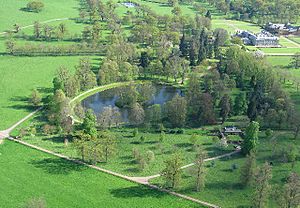
Diana was buried privately later that day. Her former husband, sons, mother, siblings, a close friend, and a clergyman were present. Diana was dressed in a black long-sleeved dress she had chosen earlier. A set of rosary beads, a gift from Mother Teresa (who died the same week), was placed in her hands. Her grave is on an island within the grounds of Althorp Park, the Spencer family home.
The 2nd Battalion The Princess of Wales's Royal Regiment carried the Princess to the island. Diana had been their Colonel-in-Chief from 1992 to 1996. The original plan was to bury her in the family vault at a local church, but her brother Lord Spencer worried about public safety and visitors. He decided she should be buried where her grave could be cared for and visited privately by William, Harry, and other family members.
Diana's Legacy
Public Image and Influence
Diana remains one of the most popular members of the Royal Family in history. She continues to influence the royal family and its younger generation. From her engagement in 1981 until her death in 1997, Diana was a huge presence globally, often called the "world's most photographed woman." She was known for her kindness, style, charm, and important charity work.
In 1997, Time magazine considered Diana for "Man of the Year." In 1999, Time named her one of the 100 Most Important People of the 20th Century. In 2002, Diana was ranked third in a BBC poll of the 100 Greatest Britons, even higher than other British monarchs.
Fashion Icon
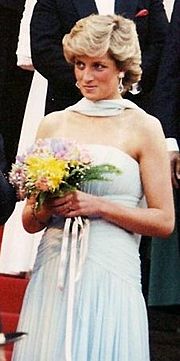
Diana was a fashion icon whose style was copied by women worldwide.
The Princess chose her clothes based on both royal traditions and popular British styles, creating her own fashion trends.
She was added to the International Best Dressed List Hall of Fame in 1989. In 2004, People magazine called her one of the most beautiful women of all time. In 2012, Time magazine included Diana on its list of All-TIME 100 Fashion Icons.
Memorials and Tributes
After her death, many places around the world became temporary memorials where people left flowers. The largest was outside Kensington Palace, where people still leave tributes. Permanent memorials include:
- The Diana, Princess of Wales Memorial Gardens in Kirkintilloch.
- The Diana, Princess of Wales Memorial Fountain in Hyde Park, London, opened by Elizabeth II.
- The Diana, Princess of Wales Memorial Playground in Kensington Gardens, London.
- The Diana, Princess of Wales Memorial Walk, a path connecting several London parks.
- The Diana Memorial Award, started in 1999 to honor young people.
- The Princess Diana Memorial Austria, the first memorial to Diana in a German-speaking country.
The Flame of Liberty in Paris, above the tunnel where the crash happened, has become an unofficial memorial to Diana. There are also two memorials inside Harrods department store, created by Dodi Fayed's father. One is a pyramid with photos and items, and the other is a bronze statue called Innocent Victims.
Two types of roses are named after Diana: Rosa 'Princess of Wales' (a white rose) and Rosa 'Diana, Princess of Wales' (a pink rose). Money from selling these roses has been donated to charities.
In 1998, Azermarka and HayPost issued postage stamps commemorating Diana in Azerbaijan and Armenia. Other countries also issued stamps.
In 2013, a new arts center at OCAD University in Toronto was named the Princess of Wales Visual Arts Centre. Princess Diana Drive in Trenton, New Jersey, was also named in her memory. Diana's granddaughter, Charlotte Elizabeth Diana, and her niece, Charlotte Diana, are named after her.
In 2017, Diana's sons asked for a statue of their mother to be placed at Kensington Palace to mark 20 years since her death. They said, "Our mother touched so many lives. We hope the statue will help all those who visit Kensington Palace to reflect on her life and her legacy."
Titles and Styles
- 1 July 1961 – 9 June 1975: The Honourable Diana Frances Spencer
- 9 June 1975 – 29 July 1981: Lady Diana Frances Spencer
- 29 July 1981 – 28 August 1996: Her Royal Highness The Princess of Wales
- in Scotland: Her Royal Highness The Duchess of Rothesay
- in Chester: The Countess of Chester
- 28 August 1996 – 31 August 1997: Diana, Princess of Wales
Even after her death, she is most often called "Princess Diana," though this was not her formal title. She is also sometimes called "Lady Diana Spencer" or "Lady Di." After her death, Prime Minister Tony Blair called Diana the People's Princess.
Children and Grandchildren
| Name | Birth | Marriage | Issue | |
|---|---|---|---|---|
| Date | Spouse | |||
| Prince William, Duke of Cambridge | 21 June 1982 | 29 April 2011 | Catherine Middleton | |
| Prince Harry, Duke of Sussex | 15 September 1984 | 19 May 2018 | Meghan Markle | |
Images for kids
-
The Prince and Princess of Wales with Nancy Reagan and Ronald Reagan in November 1985.
-
Diana with US First Lady Barbara Bush in the Yellow Oval Room, 1990.
-
US First Lady Hillary Clinton and Diana chat in the Map Room following a landmines campaign fund-raiser, June 1997.
-
Diana meeting with Sri Chinmoy at Kensington Palace in May 1997.
-
John Travolta and Diana dancing at the White House, November 1985.
-
Wax statue of Diana at Madame Tussauds in London.
See also
 In Spanish: Diana de Gales para niños
In Spanish: Diana de Gales para niños



